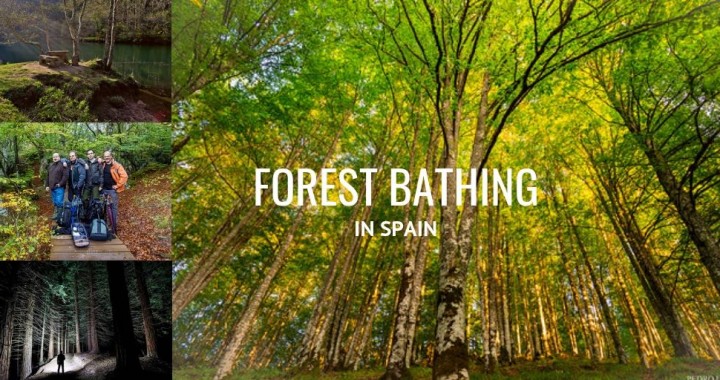When we say forest bathing in Spain, we don’t mean swimming in the conventional sense. We mean surrounding yourself in the beauty of the forest – whether that’s walking, trekking or simply having a picnic or reading a book under the shade of the trees. Perhaps you already practice Shinrin-yoku (forest bathing) which emerged from Japan in the 1980s. Or maybe you just believe in the calming effects that time in the forest can have on our health. In addition to boasting the cleanest air and sense of wellness, the beauty of Spain’s forests all year round is something we never take for granted here at Totally Spain. If you’d like to experience them for yourself, here are our favourites:-
Forest Bathing in Spain
The 10 best locations for forest bathing in Spain are:-
1 Sequoias del Monte Forest (Cantabria)
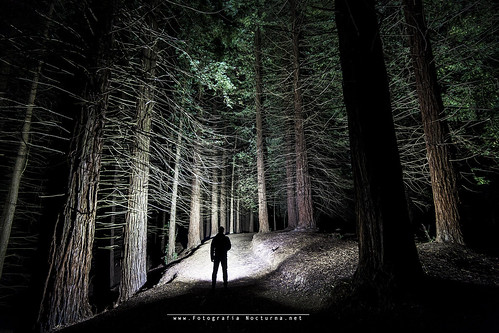
The amazing redwoods pictured by night at the Sequoias del Monte Forest near Cabezon de la Sal in Cantabria. photo credit: www.fotografianocturna.net El Bosque de Secuoyas Nitecore TM10K via photopin (license)
This National monument dates from the 1940s when 800 redwoods were planted for their fast growth yet were never cut as had been planned. Today, many of the trees soar up to 50m in height. It’s not a long walk (just 2.5 hectares) but it is a unique one which your family, friends and pets will enjoy. We challenge you to visit this forest and not hug one of the trees – the barks are so tactile. And the photos from here are always amazing so you’ll take away a brilliant keepsake too! To get here, your nearest town is Cabezon de la Sal, a charming agricultural hive of activity inland – and the forest is 2km from Cabezon. To make a great day trip from Santander or Bilbao, combine the forest visit (which takes no more than an hour) with some time enjoying Cantabria’s cave art or Gaudi’s Capricho in Comillas. This Redwood forest is included in our post on Cantabria in Autumn and 21 Images that Define Cantabria.
2 Selva de Irati (Navarra)
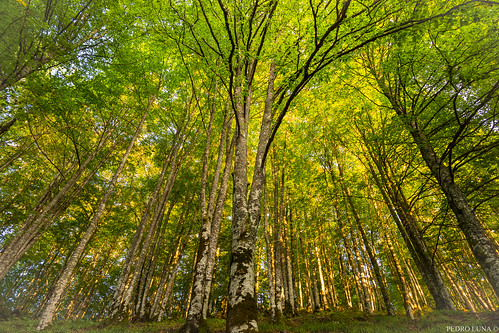
The beech and fir forest in full technicolour at the Selva de Irati in Navarra. photo credit: Wildlife and Nature Photos! Basque country via photopin (license)
The second largest and best preserved beech and fir forest in Europe with 17,000 hectares in an almost unspoiled state in the Western Pyrenees of Navarra (next to the border with France). To get here, head for the picturesque villages of Ochagavía (on the west) or Orbaitzeta (5km east of the forest, where you’ll find an interpretation centre). Inside the forest, the only noise you’ll hear is the wild rushing of water. This landscape is full of streams and torrents including the Urbeltza and the Urtxuria, which come together at the foot of the chapel of la Virgen de las Nieves to create the river Irati. You might also hear the birds such as goldcrests, finches, robins, woodpeckers and mammals like foxes, wild boar, stags and deer. In addition to the beech and pine trees, you’ll also encounter hazelnut, elm, willow, maple, box, and juniper trees, together with fern, lichens, moss, sloe berries and solitary oaks. The variety of colour reaches its peak in Autumn when warm browns, intense yellows and dreamy reds tinge the tops of the trees. This forest is perfect for a walk or hike – and you can also bike here or when the weather demands it, strap on your snow shoes or skis. If you’d like to explore more of this area, Roncesvalles is just an hour away – this is the starting point for the Camino de Santiago. To read more about Spain’s Pyrenees, check out our Pyrenees Parador tour here.
3 Fragas do Eume (A Coruña)
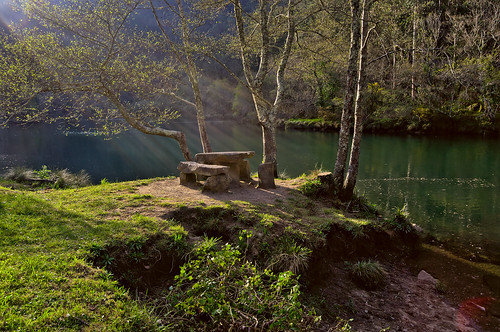
In need of a break? This picnic table is waiting for you at the Fragas do Eume Forest in A Coruña. photo credit: xosediego Here comes the spring – Fragas do Eume – Galicia via photopin (license)
One of the best-preserved riverside Atlantic forests in Europe. With less than 500 people residing within its 9,000 hectares, these lush forests that follow the course of the River Eume are practically untouched. It shouldn’t need to be said – but the best way to discover the park is on foot. That’s how you get to appreciate the oak, poplar, ash and alder trees, and more than 20 species of lichens and ferns 200 that live here. Hidden in the depths of the forest, you’ll find the monastery of San Xoan de Caaveiro, from where to enjoy the splendid views. This makes for a wonderful walk – have your well-deserved picnic on the church steps and take in the magic all around! This forest is less than an hour’s drive from A Coruna and 80 mins drive from Santiago de Compostela – capital of Galicia and home to one of Spain’s most famous cathedrals.
4 Faedo de Ciñera (León)
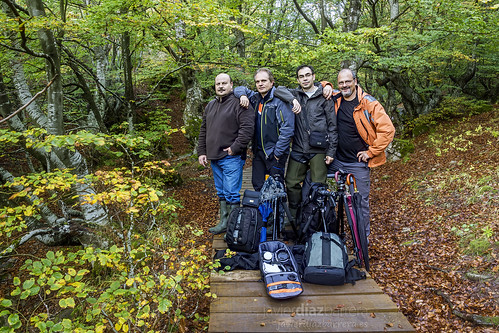
Enjoying the day out at the Faedo de Ciñera in León. photo credit: Javier Díaz Barrera (javierdiazbarrera.es) “Los Domingueros” atacan de nuevo  via photopin (license)
via photopin (license)
An hour’s drive from Leon city, this is a fairytale century-old beech forest in an excellent state of conservation – being awarded Spain’s best kept forest in 2007 – and part of Los Argüellos Listed Biosphere. Park your car at Ciñera de Gordón (a former mining town) and walk the 2-km trail to get to the forest. Along the way, you’ll find many vestiges of the mining past here from memorials to crossed-off openings to mines. As you walk along the wooden pathways, you’ll reach the forest – see if you can find Fagus – a tree that is 512 years-old. If that’s not incentive to explore this space – carry on along the trail to Hoces de Villar rather than turning back and you’ll get to see a gorge as you walk the additional 8km of this circular route. This was the pathway taken by the miners from Villar del Río to get to the mine.
5 Bosque de Oma (Vizcaya)
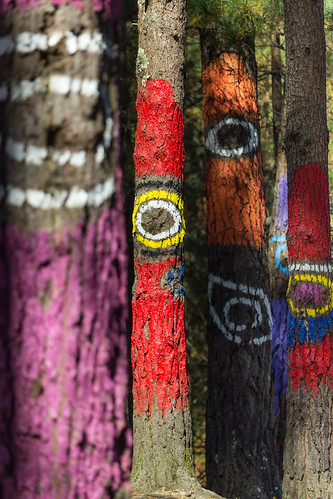
Extra colour on show at the Painted Forest in Bosque de Oma in Viscaya. photo credit: Stefano Avolio El Bosque Pintado via photopin (license)
Forests are never short of colour especially in Autumn – but this one is bounding with vibrant tones all year long – thanks to the handiwork of Bilbao-based sculptor and artist Agustín Ibarrola back in 1984. The Bosque Animado (the Animated Forest) is close to Santimamiñe Caves and the artist was keen to link the works of the ancestral Palaeolithic artists with the modern art movement known as land art. It’s such a simple idea and it never fails to bring a smile to visitors’ faces. And it’s not just a few pine trees – Ibarrola covered thousands here. To locate the Painted Forest, go to the peaceful town of Kortezubi, right in the heart of the Urdaibai Biosphere Reserve. The alternative ‘open-air gallery’ is just 35 mins by car from Bilbao and 45 mins from Gaztelugatxe – a wonderful monastery made famous of late by the Game of Thrones. For more, see our guides to Bilbao and the Basque Country.
6 Bosque de Muniellos (Asturias)
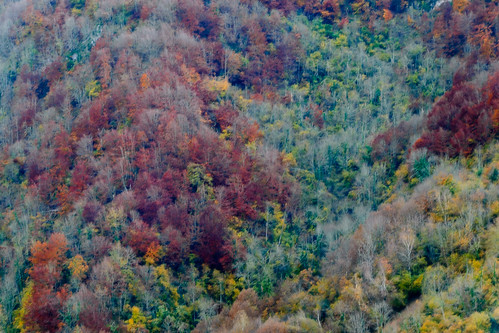
You might cross paths with brown bears, wolves, foxes and wild boars at the Bosque de Muniellos in Asturias. photo credit: Oscar F. Hevia Hayedo via photopin (license)
The largest oak forest in Spain situated in the heart of Asturias. Mountains, valleys and numerous streams make up much of this space, where the natural environment has remained practically undisturbed. The mountains of Muniellos, La Viliella and Valdebois constitute the nucleus of the reserve. One of the most interesting trails in the reserve leads to the lagoons of Candanosa Peak, the glacial origins of which date back thousands of years. The extensive forests and undergrowths in the reserve provide shelter to brown bears, wolves, foxes, wild boars, roe deer and many other species from the Cantabrian fauna. As you ascend you’ll get to see snow on the peaks pretty much all year round. Get in touch with us to get a pass as access is restricted to groups of twenty people a day and must be booked in advance if you want to experience the huge array of species of oak with canopies of up to six metres in diameter, as well as beech, birch, holly and yew. This forest is a 2 hour drive from Oviedo – so don’t set out without planning in advance. To compliment the visit to the forest with some Asturias coastline, see our guide to Northern Spain’s pretty ports and fishing villages here.
7 Hayedo de Montejo (Madrid)
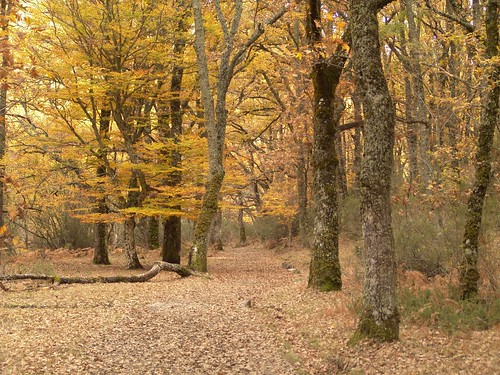
Access to the Hayedo de Montejo Forest is limited – to ensure it stays as beautiful as it looks in this photo! photo credit: Xosé Castro Hayas y robles en el hayedo de Montejo. Beech and oak trees in the Montejo beech wood. via photopin (license)
Located at the foot of the Sierra de Ayllón, this UNESCO World Heritage Site features an old meadow of beeches, oak trees and Pyrenean oak. With 25,000 visitors every year, you know the 250 hectares on the banks of the Jarama River is pretty special. Home to 833 species of plants and 194 species of vertebrae as well as the 500-year-old, 20-meters-tall beech tress plus the 100-year-old oaks, holly and ash trees – and you can join in the fun too. But remember this forest is a protected environment, so visitors cannot walk around on their own. Guided tours, which are free of charge, are led by experts who reveal the secrets of the forest on a series of hikes through this unique landscape. NB Access is limited – we can request a pass online – or you can try secure one on the day from the Information Centre of the Biosphere Reserve in the town of Montejo de la Sierra which is an 11-min drive from the forest. The forest is just 90 mins by car from the capital. We can recommend a few more stop-offs nearby including Pedraza and Rascafria before you head back to the urban jungle that is Madrid.
8 Fageda d’en Jorda (Girona)
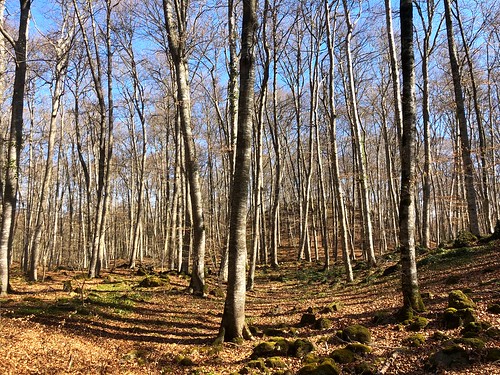
Did somebody mention a volcano? Don’t worry – the Fageda d’en Jorda in Girona has been 500 years free from any seismic activity! photo credit: Joanbrebo Fageda O017. via photopin (license)
Standing at 550m above the sea on the fertile land cast from Croscat Volcano, this beech forest has been a source of inspiration for artists such as Joan Maragall, who wrote the poem that gave this forest its fame. Access is via a number of location (Can Serra, Olot, Santa Pau) on foot to this part of the Garrotxa Volcanic Zone Natural Park. And don’t let the name put you off – it’s been 500 years since any seismic activity and 10,000 years since the last eruption. This forest is less than an hour from Girona and even closer to Besalu – which we’ve included in our guide to Day Trips from Barcelona and Jewish Heritage Sights in Spain.
9 Fageda de la Grevolosa (Barcelona)
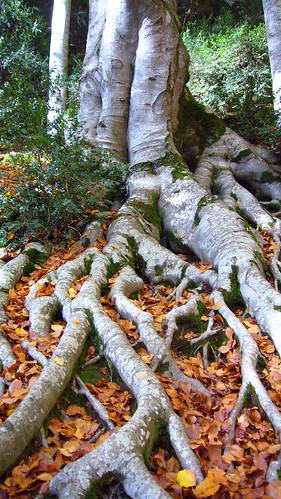
Tree hugging some of these old beauties at the Fageda de la Grevolosa in Barcelona isn’t so easy! photo credit: Jofre Ferrer Arrels via photopin (license)
Some of these trees are over 300 years, exceeding 40 meters high and have a diameter of over one meter and a half! Get there in 80 mins from Barcelona and Girona – head for Serra de Llancers in the municipality of Sant Pere de Torello Osona. You can take a number of hiking trails to enjoy the colour and variety – one of which leads downhill towards Sant Nazari de la Vola chapel – the grounds of which are great for a picnic break or snack before arriving at the forest. Attempting to tree hug some of the older trees is a bit of a challenge – with all those age rings making the trunks so large! This forest is just a 30 min drive from Fageda d’en Jorda – so you could easily squeeze in another “forest swim” in the same day – and still have time for a visit to Dali’s Museum in Figueres or even the Costa Brava for an actual dip in the water!
10 Bosques del Ambroz (Caceres)
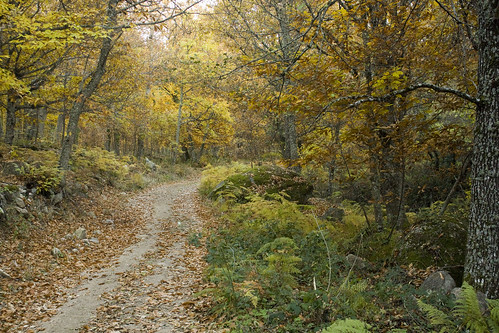
Autumn Magic – come sample some for yourself at the Bosques de Ambroz in Caceres! photo credit: elniniodelabici (arde) amb-batu_73 via photopin (license)
Chestnuts, oaks, alders, poplars, olive trees and oak – are just some of the treats in store here. If you like a good hike – there is wonderful 20km stretch starting in La Garganta and ending in Segura de Toro. You do pass through two villages where you can grab a drink or a snack but we like to pack a picnic to keep up a good pace. If you’re visiting during the Autumn, you’ll never be alone – as local initiatives have promoted the Autumn Magic experience (as it’s called) and walking groups come from all around to enjoy the wonderful colours. Although technically in Caceres, this forest is just on the border with Castile-Leon and La Alberca is just a 60-min drive away which we featured in this driving tour from Madrid to Porto. If you’re visiting in Spring, stay inside Extremadura and head for the Valle del Jerte – famous for its cherry blossom – which we’ve featured here in our guide to the Best Places to Get Engaged in Spain.
Insider Tip: Need help planning a custom Spain trip with time spent exploring one or more of these forests? Totally Spain can arrange a complete custom package for you including accommodation, and we’ll also look after your car-hire or book you a private driver. As well as booking relaxing meals at countryside taverns and arranging picnics in certain locations too. We can arrange gentle hiking routes too with a hike leader if you wish – they’ll not only do all the research and carry the responsibility – but they’ll also be able to talk to you about the flora and fauna – as well as life in the Spanish countryside.
Want to read more about the great outdoors in Spain? We’ve also written about the Camino de Santiago and encourage everybody to walk, cycle or drive a section to experience its charm. And for those of you with green fingers, have a read of our guide to the best Gardens in Spain and National Parks in Spain.
